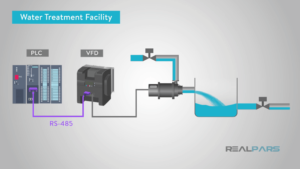Variable Frequency Drives
A variable frequency drive (VFD) controls the speed of a motor to match its output requirements, saving energy by running the equipment at less than full capacity. This is also useful for reducing noise, improving comfort, and extending motor life. VFDs are used across industry to control the speed of fans, water and process pumps, traction applications for power trains and railroads, welding power supplies, and even robotic machines.
A basic VFD is a device that regulates the frequency of incoming power to an AC motor to reduce the speed and output torque. A more advanced device will have built-in programmable logic control (PLC) functionality and extensive data communication capabilities. The core of a variable speed drive is an AC-to-DC converter, which converts the alternating current (AC) supply to direct current (DC) and then back again to AC at the desired frequency. The DC is then fed into capacitors within the drive that smooth out the electrical waveform. This allows for the drive to deliver high-quality DC power that is then fed into the motor.
An additional benefit of a variable frequency drive is a lower power factor (PF) on the line side, which will improve the overall efficiency of the system. PF is measured by the ratio of total harmonic distortion (THD) to the fundamental voltage distortion (UVD). A VFD can typically achieve an 85% reduction in THDs and UVD with an improved PF of 0.95 at full frequency, and more improvement at partial frequencies.

What Are Variable Frequency Drives?
While a VFD can help to mitigate harmonics on the load side, it is also necessary to address them on the line side. If harmonics are not eliminated on the line side, they can cause a DC bus to overheat, which can trip safety relays or short out the voltage sensing transformer. Overheating can also increase cooling costs.
The best way to eliminate harmonics on the line side of a VFD is to install a harmonic filter on the output. While these filters can be expensive, they can greatly reduce harmonic levels and reduce the risk of a faulty frequency relay trip.
While a VFD can have significant benefits in terms of energy savings and precision speed control, many companies choose to pair them with an encoder to further enhance performance. This allows the VFD to monitor the speed of a motor and react accordingly, preventing jerks in conveyor systems that could damage the belt or slow down production. This feature is particularly beneficial in rolling applications where precision is critical to avoid material deformation. This can also lead to a reduction in production downtime and lost revenue.



Recent Comments